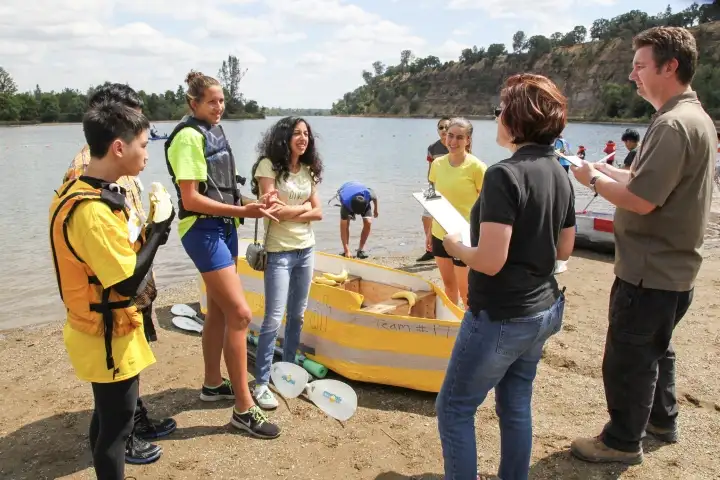Author: Rebecca Griffiths, Ed.D., Principal Education Researcher, Center for Education Research & Innovation for SRI Education

Do we need to think differently about what comprises infrastructure?
National attention is focused on the Biden administration’s $2 trillion proposal for infrastructure to support sustainable, broadly shared prosperity. A key question has arisen: What exactly counts as infrastructure? Is it only physical structures, such as roads, bridges, electric charging stations, and broadband? Or can it also encompass intangible foundations of a productive society, such as human capital and systems for providing care?
These questions have gained salience in the realm of scientific and educational research thanks in part to the National Science Foundation’s (NSF) new funding streams for mid-scale research infrastructure (Mid-Scale RI). The program is designed to support many observable forms of research infrastructure, such as lasers, laboratories, data repositories, and physical networks for sharing data; but what about social networks, organizations, and standards that guide the use of these physical infrastructures? Should these intangible structures receive support as well?
Our STEM education system faces significant challenges in creating opportunities for a more diverse population to develop scientific skills and knowledge needed for lifelong career success. Current research methods in STEM education have not yielded satisfactory solutions. At the same time, emerging technologies and increased awareness of systemic inequities are opening up new avenues of inquiry and innovation in STEM education, with the potential to lead to more authentic, effective, and equitable learning opportunities for all. In order to realize the full potential afforded by technological advances and innovations in educational approaches, new and improved infrastructures are needed. Moreover, different ways of thinking about research infrastructure are needed to enable full participation of diverse stakeholders and implementation of effective practices on a large scale.
A recent series of discussions with a selected group of stakeholders in STEM education indicated that future research infrastructure must:
- Support communication, collaboration, and understanding across geographic and education silos.
- Leverage emerging technologies to provide enriched educational opportunities in STEM and reduce the burden on educators and students of participating in research.
- Provide methods, tools, and models that are standardized, but flexible, to overcome technical, policy, and competitive barriers to data sharing and longitudinal, multifaceted research.
- Integrate multimodal data that provide insight into the factors and conditions that shape students’ lives and educational opportunities.
- Address inequities in assessment design and data systems.
- Support implementation and scaling of evidence-based practices.
- Create inclusive organizational structures to bring together diverse groups and ensure that the voices of students, parents and communities are brought to the fore.
Background
NSF’s new funding streams for Mid-Scale RI support the implementation of projects that comprise combinations of equipment, instrumentation, and computational hardware and software, as well as the necessary commissioning and human capital. The Mid-Scale RI program aims to transform scientific, engineering, and STEM education research fields by investing in new capabilities, while simultaneously training early-career researchers in the development, design, and construction of cutting-edge infrastructure. Grants in this program have supported projects such as sensor arrays, testbed facilities, research aircraft and seafloor monitors. One recent award went to support a platform for conducting exploratory research in computer networking, distributed computing systems, and applications, as well as for educating and training the next generation of researchers on future advanced distributed systems designs. Although STEM education is included in the solicitation, no projects in this field have yet been selected for funding.

To generate ideas and excitement for research infrastructure projects in STEM education, NSF awarded a grant to SRI International to conduct a series of workshops bringing together researchers, practitioners, and other key stakeholders in sectors ranging from early childhood development to informal STEM programs to postsecondary and workforce education. SRI’s approach entailed framing the pressing issues and opportunities in STEM education, and then identifying the factors that may encourage or impede progress, pointing to the need for new research infrastructure. SRI also sought to draw from salient expertise from outside the STEM education research community; for example, in light of the difficulty of conducting education research across disparate data repositories, we invited a leader from the Equality of Opportunity Project, which is well-known for integrating existing datasets to open new avenues of inquiry.
The workshops were organized around four themes:
1. What students need to learn, taking into account the cross-disciplinary skills and knowledge needed for future STEM careers and engaged citizenry.
2. Technological advances to enhance student learning, engagement and achievement, including research and applications involving artificial intelligence, virtual reality, and biometric data.
3. The ways in which diverse students advance through STEM pathways and issues of equity and inclusion.
4. Research infrastructure for undergraduate STEM education.
While one workshop was specifically focused on diversifying the STEM pipeline, issues around equity and inclusion were woven into all four of the discussions.
Challenges and opportunities for STEM education research
Workshop participants identified pressing needs in the areas of curriculum and instructional reform, equity and dimensions of student experience, connecting disparate data, and scaling and implementation. They raised concerns that current educational approaches, including assessments, are disconnected from real life and reinforce divisions among communities. Current research methods place undue burdens on educators and are too crude to provide sufficient detail and insight into learning processes. Educational experiments that test new curricula and instructional strategies are typically small in scale and hard to expand and sustain without loss of effectiveness. Moreover, these types of experiments have produced legions of disparate datasets that are difficult for researchers to access, analyze, or integrate. Educational technologies also generate reams of usage data, but these data are often proprietary and not organized according to standards that would facilitate research across multiple datasets.
Our ability to understand the experiences of students facing barriers based on race, ethnicity, language, or socioeconomic status is severely constrained by the difficulty of following students across educational and geographic boundaries. We also struggle to connect information about their educational outcomes with other dimensions of their lives that are known to influence academic outcomes, such as health, housing, nutrition, and family welfare.
Mid-Scale RI has the potential to turn the tables on these issues. Many of the ideas put forward by workshop participants leverage networked technologies to enable new forms of instruction and research methods. For example, participants suggested “collaboration infrastructure” that could enable shared learning experiences among students in different contexts around real-world problems. Digital learning platforms can simulate authentic, immersive experiences while generating detailed process data, providing deep insight into how students learn. Classrooms instrumented with cameras and biometric sensors can shed light on how interactions between teachers and students and among students enhance (or impede) learning, mitigating the burden on teachers and students to participate in more manual forms of data collection.
With necessary data infrastructure and attention to privacy and access, social media and mobile phone data might be used to better understand students’ progress, as these data sources are less affected by administrative silos that impede research using traditional data infrastructure. Multi-dimensional infrastructure would give researchers the opportunity to unify qualitative and quantitative teaching, administrative, and intervention data, identifying the multitude of influences on student choice and career pathways in STEM. This type of infrastructure could also enable tracking of important informal learning experiences that occur outside of the classroom. New assessment infrastructure is needed, as traditional metrics contain biases and do not reflect different forms of knowledge and ways in which students demonstrate knowledge.
Technologies, algorithms, and data repositories could be useful for tackling the big questions in education and allowing researchers to work across silos and expand collaboration. For learning technologies to produce useful data, new infrastructure should incorporate standards and use common definitions of important concepts (e.g., persistence and resilience). Data repositories, platforms, and artificial intelligence applications could help with data-intensive areas of study, such as speech, psychometrics, and administrative data. Several participants emphasized that decisions about which data are collected and how they are organized represent current and historical socioeconomic systems and hierarchies. New systems must be thoughtfully designed so as not to replicate existing inequities.
Finally, several researchers in both K–12 and postsecondary education argued that there is already a lot of evidence of instructional approaches that work. But replicating these practices across different contexts has been difficult. To improve the success rate of scaling up effective practices, infrastructure is needed that organizes and connects researchers, practitioners, and curriculum developers and technologies. Digital technologies can also enhance implementation research by efficiently capturing the human impact of pedagogical strategies and learning activities.
Implications for research infrastructure
As for what constitutes research infrastructure for STEM education, participants conceptualized infrastructure broadly to include social and organizational structures as well as data systems and standards. They focused on what types of systems and approaches are needed to address historical inequities and gaps more than on specific physical hardware and software needs. As the nation debates what kinds of investments in infrastructure are needed to bring about sustainable and widely shared prosperity in coming decades, this way of thinking about “infrastructure” may have broader applicability.



